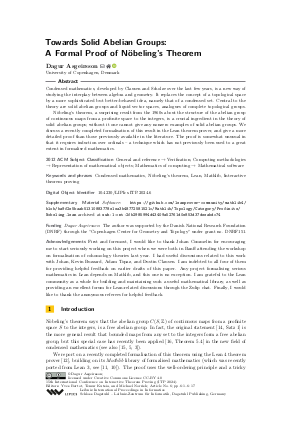LIPIcs.ITP.2024.6.pdf
- Filesize: 0.71 MB
- 17 pages

 Creative Commons Attribution 4.0 International license
Creative Commons Attribution 4.0 International license

Condensed mathematics, developed by Clausen and Scholze over the last few years, is a new way of studying the interplay between algebra and geometry. It replaces the concept of a topological space by a more sophisticated but better-behaved idea, namely that of a condensed set. Central to the theory are solid abelian groups and liquid vector spaces, analogues of complete topological groups. Nöbeling’s theorem, a surprising result from the 1960s about the structure of the abelian group of continuous maps from a profinite space to the integers, is a crucial ingredient in the theory of solid abelian groups; without it one cannot give any nonzero examples of solid abelian groups. We discuss a recently completed formalisation of this result in the Lean theorem prover, and give a more detailed proof than those previously available in the literature. The proof is somewhat unusual in that it requires induction over ordinals - a technique which has not previously been used to a great extent in formalised mathematics.




Feedback for Dagstuhl Publishing